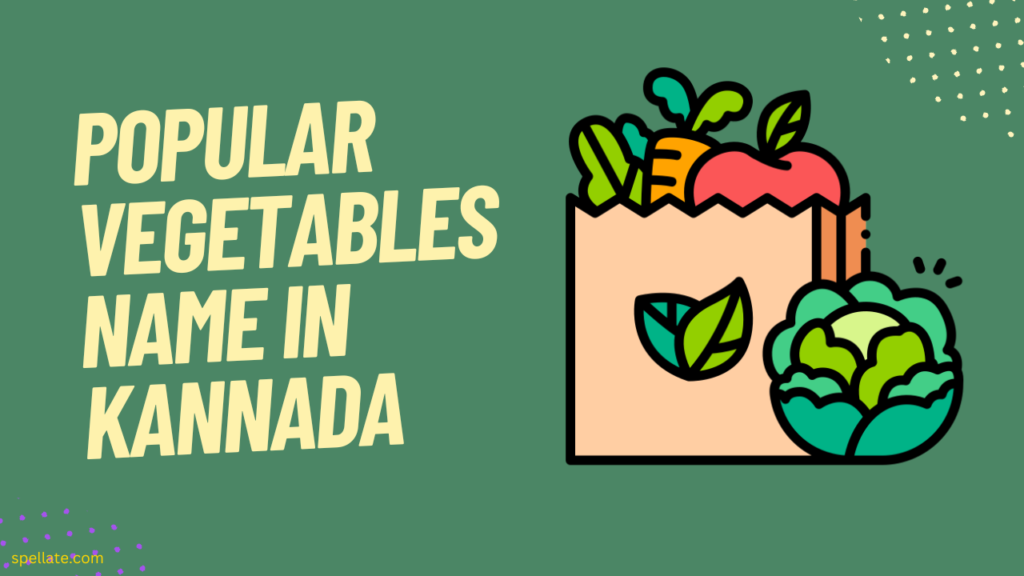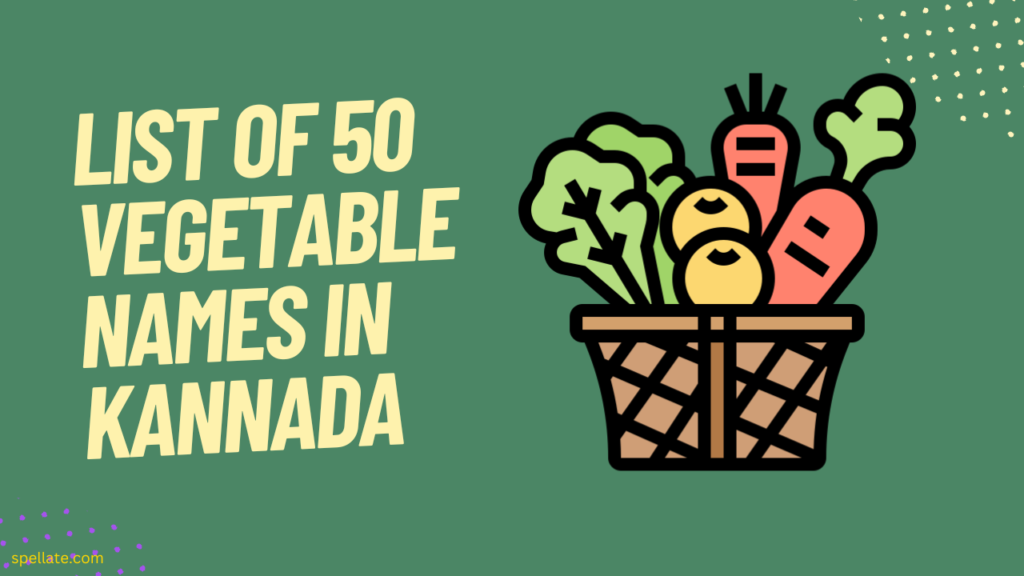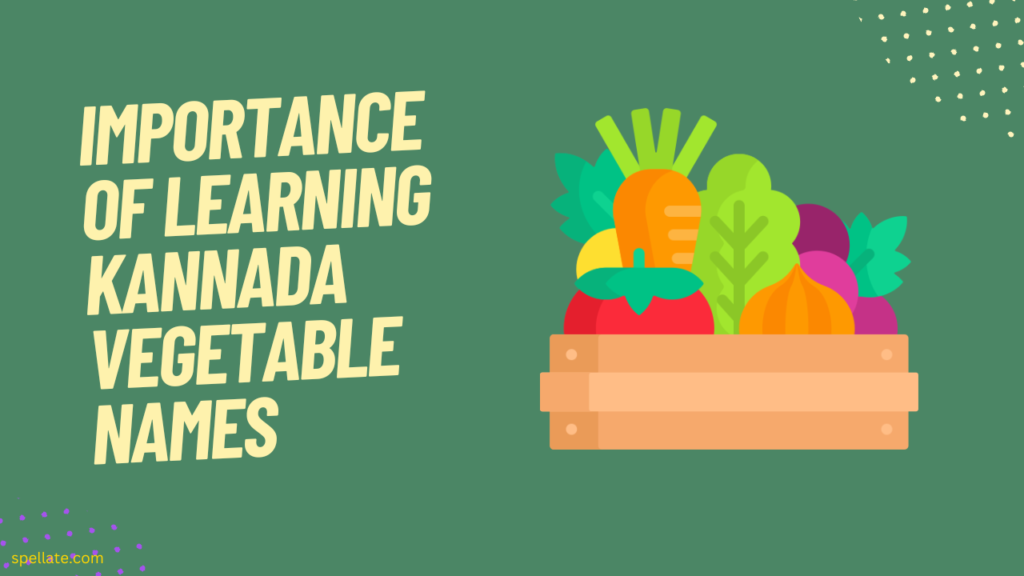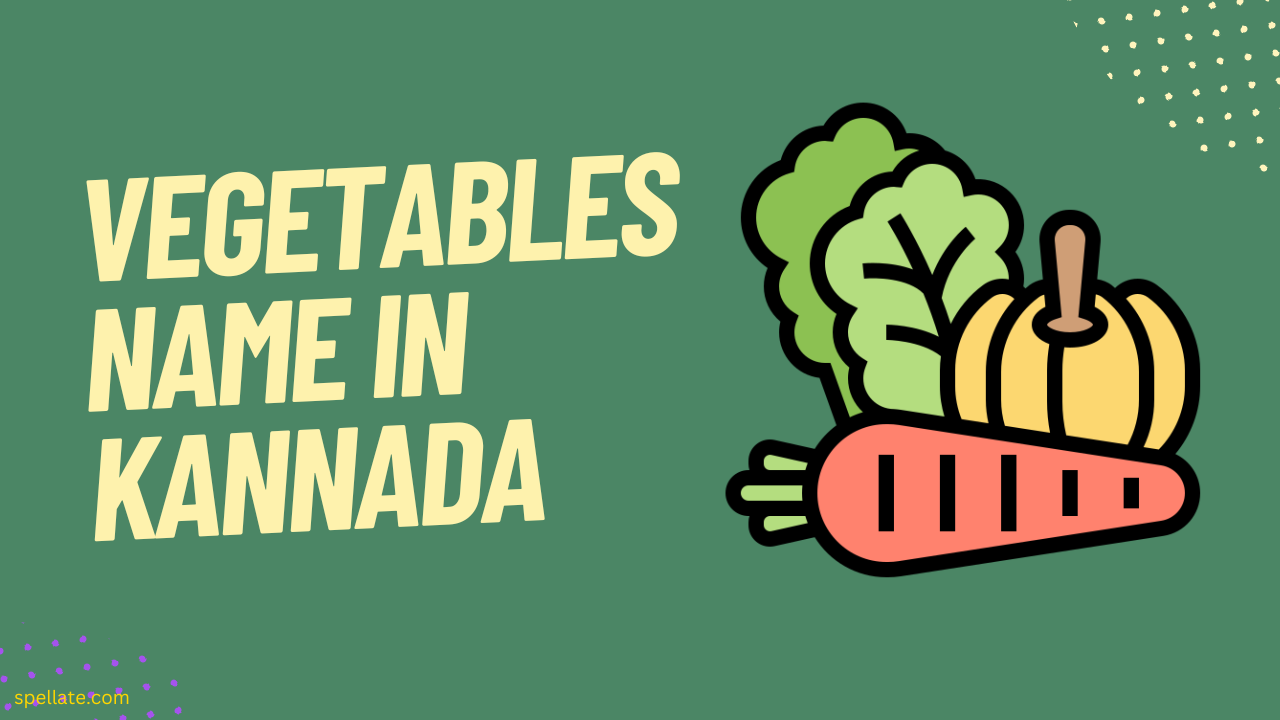Welcome to the world of Kannada vegetables! Kannada, one of the major Dravidian languages spoken in southern India, has a rich vocabulary when it comes to naming vegetables. With its unique script and pronunciation, Kannada brings forth a colorful array of names that reflect the cultural diversity and culinary heritage of the region.
Whether you’re a language enthusiast, a traveler, or simply looking to expand your knowledge, this guide will introduce you to a variety of vegetables name in Kannada. Get ready to explore the bountiful world of Kannada vegetables and discover the delightful flavors they bring to the table. Let’s dive in and uncover the vibrant world of “Vegetables in Kannada”!
- Popular Vegetables name in Kannada
- 1. Potato – ಆಲೂಗಡ್ಡೆ (Alugadde):
- 2. Tomato – ಟೊಮ್ಯಾಟೊ (Tomato):
- 3. Onion – ಈರುಳ್ಳಿ (Erulli):
- 4. Carrot – ಗಾಜರ್ (Gajar):
- 5. Cabbage – ಎಲೆಕೋಸು (Elekosu):
- 6. Cauliflower – ಹೂಕೋಸು (Hūkosu):
- 7. Brinjal/Eggplant – ಬದನೇಕಾಯಿ (Badanekāyi):
- 8. Beans – ಹುರಳೀಕಾಯಿ (Huralīkāyi):
- 9. Spinach – ಪಾಲಕ್ (Pālak):
- 10. Pumpkin – ಕುಂಬಳಕಾಯಿ (Kumbalakāyi):
- 11. Radish – ಮೂಲೆಂಗಿ (Mūlengi):
- 12. Capsicum – ದೊಡ್ಡ ಮೆಣಸಿನಕಾಯಿ (Dodda Menasinakāyi):
- 13. Beetroot – ಬೀಟ್ರೂಟ್ (Bīṭrūṭ):
- 14. Ladyfinger/Okra – ಬೆಂಡೆಕಾಯಿ (Bendekāyi):
- 15. Bottle gourd – ಸೊರೆಕಾಯಿ (Sorekāyi):
- List of 50 Vegetable names in Kannada
Popular Vegetables name in Kannada

Kannada, one of the oldest Dravidian languages spoken in South India, is known for its rich vocabulary and unique phonetics. It’s no wonder that even vegetables have a different name in this language. Kannada has a vast list of vegetables that are popularly grown and consumed in the region. Here are some popular vegetables name in Kannada:
1. Potato – ಆಲೂಗಡ್ಡೆ (Alugadde):
In Kannada, potato is known as “ಆಲೂಗಡ್ಡೆ” (Alugadde). The word “ಆಲೂ” (Alu) refers to potato, and “ಗಡ್ಡೆ” (Gadde) means root or tuber. So, when combined, “ಆಲೂಗಡ್ಡೆ” (Alugadde) translates to “potato.” Potatoes are widely used in various cuisines and are a versatile vegetable that can be boiled, roasted, mashed, or used in curries and other dishes.
2. Tomato – ಟೊಮ್ಯಾಟೊ (Tomato):
The Kannada name for tomato is “ಟೊಮ್ಯಾಟೊ” (Tomato). The word “ಟೊಮ್ಯಾಟೊ” (Tomato) is borrowed from the English term “tomato.” It is commonly used in its transliterated form in Kannada. Tomatoes are widely used in Indian cuisine, lending their tangy and juicy flavor to curries, chutneys, salads, and other dishes.
3. Onion – ಈರುಳ್ಳಿ (Erulli):
In Kannada, onion is referred to as “ಈರುಳ್ಳಿ” (Erulli). The term “ಈರುಳ್ಳಿ” (Erulli) specifically refers to the bulbous vegetable we commonly know as an onion. Onions are an essential ingredient in cooking, providing a distinct flavor and aroma to a wide range of dishes. They can be used raw in salads, cooked in curries and stir-fries, or caramelized for added sweetness.
4. Carrot – ಗಾಜರ್ (Gajar):
In Kannada, carrot is known as “ಗಾಜರ್” (Gajar). The word “ಗಾಜರ್” (Gajar) is borrowed from Hindi, where it also means carrot. Carrots are root vegetables that are known for their bright orange color and sweet flavor. They are rich in vitamins, minerals, and dietary fiber. In Kannada cuisine, carrots are used in various ways, such as in curries, salads, stir-fries, and even desserts.
5. Cabbage – ಎಲೆಕೋಸು (Elekosu):
The Kannada name for cabbage is “ಎಲೆಕೋಸು” (Elekosu). The word “ಎಲೆಕೋಸು” (Elekosu) is a compound word that consists of “ಎಲೆ” (ELe), meaning leaf, and “ಕೋಸು” (kōsu), referring to cabbage. Cabbage is a leafy vegetable that belongs to the Brassica family. It has dense, layered leaves that are commonly used in salads, coleslaws, stir-fries, and various cooked dishes in Kannada cuisine.
6. Cauliflower – ಹೂಕೋಸು (Hūkosu):
In Kannada, cauliflower is referred to as “ಹೂಕೋಸು” (Hūkosu). The word “ಹೂಕೋಸು” (Hūkosu) is a compound word where “ಹೂ” (Hū) translates to flower and “ಕೋಸು” (kōsu) means cabbage. Cauliflower is a cruciferous vegetable that is known for its dense, flower-like head. It is commonly used in curries, stir-fries, rice dishes, and even as a low-carb substitute for rice in certain recipes.
7. Brinjal/Eggplant – ಬದನೇಕಾಯಿ (Badanekāyi):
In Kannada, brinjal or eggplant is known as “ಬದನೇಕಾಯಿ” (Badanekāyi). The word “ಬದನೇಕಾಯಿ” (Badanekāyi) is a combination of two words: “ಬದನೇ” (Badane), meaning round, and “ಕಾಯಿ” (Kāyi), which translates to fruit or vegetable. Brinjal is a versatile vegetable that comes in various shapes, sizes, and colors. It is used in numerous dishes, such as curries, stir-fries, and stuffed preparations, in Kannada cuisine.
8. Beans – ಹುರಳೀಕಾಯಿ (Huralīkāyi):
In Kannada, beans are referred to as “ಹುರಳೀಕಾಯಿ” (Huralīkāyi). The word “ಹುರಳೀಕಾಯಿ” (Huralīkāyi) specifically refers to the long, slender variety of beans commonly used in cooking. Beans are a nutritious and protein-rich vegetable. They can be used in various dishes, such as curries, stir-fries, soups, and salads. They are a popular ingredient in many traditional Kannada recipes.
9. Spinach – ಪಾಲಕ್ (Pālak):
In Kannada, spinach is known as “ಪಾಲಕ್” (Pālak). The term “ಪಾಲಕ್” (Pālak) is borrowed from Hindi, where it also means spinach. Spinach is a leafy green vegetable that is highly nutritious and packed with vitamins and minerals. It is commonly used in cooking, such as in curries, soups, stir-fries, and even as a filling in savory snacks. Spinach is known for its vibrant green color and earthy flavor.
10. Pumpkin – ಕುಂಬಳಕಾಯಿ (Kumbalakāyi):
In Kannada, pumpkin is known as “ಕುಂಬಳಕಾಯಿ” (Kumbalakāyi). The word “ಕುಂಬಳ” (Kumbala) refers to pumpkin, and “ಕಾಯಿ” (Kāyi) means fruit or vegetable. So, when combined, “ಕುಂಬಳಕಾಯಿ” (Kumbalakāyi) translates to “pumpkin.” Pumpkins are large, round, and often orange-colored vegetables that are commonly used in cooking. They can be roasted, boiled, steamed, or used in curries, soups, and desserts.
11. Radish – ಮೂಲೆಂಗಿ (Mūlengi):
In Kannada, radish is referred to as “ಮೂಲೆಂಗಿ” (Mūlengi). The word “ಮೂಲೆಂಗಿ” (Mūlengi) specifically refers to the vegetable we commonly know as radish. Radishes are root vegetables known for their crisp texture and peppery flavor. They can be consumed raw in salads or pickled, and they are also used in various cooked dishes in Kannada cuisine.
12. Capsicum – ದೊಡ್ಡ ಮೆಣಸಿನಕಾಯಿ (Dodda Menasinakāyi):
The Kannada name for capsicum is “ದೊಡ್ಡ ಮೆಣಸಿನಕಾಯಿ” (Dodda Menasinakāyi). The phrase “ದೊಡ್ಡ ಮೆಣಸಿನಕಾಯಿ” (Dodda Menasinakāyi) means “big chili” in English. Capsicums are commonly referred to as “chili” or “bell pepper” in various Indian languages, including Kannada. They come in different colors, such as green, red, and yellow, and have a mild and slightly sweet flavor. Capsicums are widely used in cooking, whether in salads, stir-fries, stuffed preparations, or as a colorful addition to various dishes.
13. Beetroot – ಬೀಟ್ರೂಟ್ (Bīṭrūṭ):
In Kannada, beetroot is known as “ಬೀಟ್ರೂಟ್” (Bīṭrūṭ). The word “ಬೀಟ್ರೂಟ್” (Bīṭrūṭ) is borrowed from English, where it also means beetroot. Beetroot is a root vegetable known for its vibrant purple-red color and earthy flavor. It can be consumed raw in salads, pickled, or cooked in various dishes such as curries, soups, and even desserts.
14. Ladyfinger/Okra – ಬೆಂಡೆಕಾಯಿ (Bendekāyi):
In Kannada, ladyfinger or okra is referred to as “ಬೆಂಡೆಕಾಯಿ” (Bendekāyi). The word “ಬೆಂಡೆಕಾಯಿ” (Bendekāyi) specifically refers to the vegetable we commonly know as ladyfinger or okra. Ladyfinger is a slender, green vegetable with a distinct shape and texture. It is commonly used in various dishes, such as curries, stir-fries, and even as a thickening agent in soups and stews.
You May Also Like
15. Bottle gourd – ಸೊರೆಕಾಯಿ (Sorekāyi):
The Kannada name for bottle gourd is “ಸೊರೆಕಾಯಿ” (Sorekāyi). The term “ಸೊರೆಕಾಯಿ” (Sorekāyi) specifically refers to the long, cylindrical vegetable we commonly know as the bottle gourd. Bottle gourd has a mild flavor and a high water content, making it a popular choice for curries, soups, stews, and even desserts in some cases. It is also used to make refreshing drinks and juices.
List of 50 Vegetable names in Kannada

Kannada is a beautiful language spoken by people in the southern state of Karnataka, India. It is known for its rich culture and cuisine. One of the hallmarks of Karnataka’s culinary tradition is its use of vegetables. Vegetables are an essential part of Kannada cuisine and are used in various dishes. In this article, we have compiled a list of 50 vegetables name in Kannada to help you explore and enjoy this delicious cuisine.
| No | English | Kannada |
| 1 | Potato | ಆಲೂಗಡ್ಡೆ (Alugadde) |
| 2 | Tomato | ಟೊಮ್ಯಾಟೊ (Tomato) |
| 3 | Onion | ಈರುಳ್ಳಿ (Erulli) |
| 4 | Carrot | ಗಾಜರ್ (Gajar) |
| 5 | Cabbage | ಎಲೆಕೋಸು (Elekosu) |
| 6 | Cauliflower | ಹೂಕೋಸು (Hūkosu) |
| 7 | Brinjal/Eggplant | ಬದನೇಕಾಯಿ (Badanekāyi) |
| 8 | Beans | ಹುರಳೀಕಾಯಿ (Huralīkāyi) |
| 9 | Spinach | ಪಾಲಕ್ (Pālak) |
| 10 | Pumpkin | ಕುಂಬಳಕಾಯಿ (Kumbalakāyi) |
| 11 | Radish | ಮೂಲೆಂಗಿ (Mūlengi) |
| 12 | Capsicum | ದೊಡ್ಡ ಮೆಣಸಿನಕಾಯಿ (Dodda Menasinakāyi) |
| 13 | Beetroot | ಬೀಟ್ರೂಟ್ (Bīṭrūṭ) |
| 14 | Ladyfinger/Okra | ಬೆಂಡೆಕಾಯಿ (Bendekāyi) |
| 15 | Bottle gourd | ಸೊರೆಕಾಯಿ (Sorekāyi) |
| 16 | Drumstick | ನುಗ್ಗೆಕಾಯಿ (Nuggekāyi) |
| 17 | Ridge gourd | ಹೀರೆಕಾಯಿ (Hīrekāyi) |
| 18 | Bitter gourd | ಹಾಗಲಕಾಯಿ (Hāgalakāyi) |
| 19 | Snake gourd | ಪಡವಂಗಡೆ (Padavangade) |
| 20 | Green chilli | ಹಸಿ ಮೆಣಸಿನಕಾಯಿ (Hasi Menasinakāyi) |
| 21 | Coriander | ಕೊತ್ತಂಬರಿ (Kothambari) |
| 22 | Curry leaves | ಕರಿಬೇವು (Karibevu) |
| 23 | Mint | ಪುದೀನ (Pudīna) |
| 24 | Fenugreek | ಮೆಂತ್ಯ (Mentya) |
| 25 | Ginger | ಶುಂಠಿ (Shunthi) |
| 26 | Garlic | ಬೆಳ್ಳುಳ್ಳಿ (Bellulli) |
| 27 | Turmeric | ಅರಿಶಿನ (Arishina) |
| 28 | Green peas | ಬಟಾಣಿ (Baṭāṇi) |
| 29 | Sweet corn | ಮಕ್ಕಳೆ (Makkale) |
| 30 | Beet greens | ಬೀಟ್ ಸೊಪ್ಪು (Bīṭ Soppu) |
| 31 | Amaranth | ದಂಟು (Dantu) |
| 32 | Turnip | ನೂಲೆಂಗೆ (Nūlengae) |
| 33 | Yam | ಸುರಣೆಕಾಯಿ (Suraṇekāyi) |
| 34 | Colocasia | ಈರುಳ್ಳಿ ಗೆಣಸು (Erulli Genasu) |
| 35 | Cluster beans | ಗೋರಿಕಾಯಿ (Gōrikāyi) |
| 36 | Ivy gourd | ತೊಂಡೆಕಾಯಿ (Tondekāyi) |
| 37 | Ash gourd | ಬೂದು ಕುಂಬಳಕಾಯಿ (Būdu Kumbalakāyi) |
| 38 | Tindora | ಟಿಂಡೋರ (Tindōra) |
| 39 | Red pumpkin | ಕೆಂಪು ಕುಂಬಳಕಾಯಿ (Kempu Kumbalakāyi) |
| 40 | Plantain | ಬಾಳೆ ಹಣ್ಣು (Bāḷe Haṇṇu) |
| 41 | Drumstick leaves | ನುಗ್ಗೆ ಸೊಪ್ಪು (Nugge Soppu) |
| 42 | Onion greens | ಈರುಳ್ಳಿ ಸೊಪ್ಪು (Erulli Soppu) |
| 43 | Shallots | ಉಳ್ಳಿ ಹುಳುಸಿ (Uḷḷi Hulusi) |
| 44 | Curry beans | ಕಾಳುಕೆಂಪು (Kālukempu) |
| 45 | Leek | ಕುಂದೂರು (Kundūru) |
| 46 | Brussels sprouts | ಸಸಿವೆ ಕೋಸು (Sasive Kōsu) |
| 47 | Spring onion | ಹಳ್ಳೆ ಈರುಳ್ಳಿ (Haḷḷe Erulli) |
| 48 | Celery | ಸೆಲರಿ (Seleri) |
| 49 | Broccoli | ಬ್ರೋಕೊಲಿ (Brok |
Importance of learning Kannada vegetable names

Kannada is the official language of Karnataka, a state in south India. It has a rich cultural heritage and is known for its diverse range of cuisines. Knowing the names of vegetables in Kannada can be extremely beneficial for anyone who is interested in learning about this culture. Learning Kannada vegetable names is important for several reasons:
Communication:
Knowing the vegetables name in Kannada enables effective communication with Kannada-speaking individuals. Whether you are shopping for groceries, dining out, or interacting with locals, being able to communicate and understand vegetable names in Kannada facilitates smooth interactions and avoids confusion.
Cultural Understanding:
Kannada vegetable names provide insights into the local culture and culinary traditions. Kannada cuisine is known for its rich variety of vegetarian dishes, and understanding the vegetables name in Kannada helps in exploring and appreciating the diverse range of dishes prepared in the region.
Shopping and Cooking:
If you are residing in a Kannada-speaking region or cooking Kannada recipes, knowing the vegetables name in Kannada is essential for grocery shopping and cooking. It allows you to identify the specific vegetables you need, ensuring you select the right ingredients and create authentic Kannada dishes.
Health and Nutrition:
Learning Kannada vegetable names can be beneficial for your health and nutrition. By knowing the names of different vegetables, you can make informed choices when selecting and consuming them. It enables you to incorporate a variety of vegetables into your diet, ensuring a balanced and nutritious intake of vitamins, minerals, and dietary fiber.
Local Integration:
If you are living in a Kannada-speaking region, learning vegetables names in Kannada helps in integrating into the local community. It shows respect for the local language and culture, and it can also be a conversation starter, allowing you to engage with Kannada speakers on topics related to food and cooking.
Final Thoughts
In conclusion, learning the vegetables name in Kannada is not only practical but also enriching. It allows for effective communication, promotes cultural understanding, facilitates grocery shopping and cooking, and supports a healthier lifestyle. By familiarizing yourself with Kannada vegetable names, you can engage more confidently with Kannada-speaking individuals, appreciate the culinary traditions of the region, make informed dietary choices, and integrate into the local community. So, take the opportunity to expand your knowledge of vegetables name in Kannada and embrace the benefits that come with it.
FAQs
What is Karnataka’s traditional food?
Karnataka is known for its diverse cuisine, and traditional food varies across different regions of the state. Some popular traditional dishes include:
- Bisi Bele Bath: A flavorful rice dish made with lentils, vegetables, and aromatic spices.
- Mysore Masala Dosa: A crispy rice and lentil crepe filled with a spicy potato filling and served with chutney and sambar.
- Ragi Mudde: Steamed finger millet dumplings, typically eaten with a variety of curries.
- Maddur Vada: A deep-fried snack made with a mixture of flour, semolina, onions, and spices.
- Kundapura Koli Saaru: A spicy chicken curry with a distinct flavor from the coastal region of Kundapura.
- Mangalorean Fish Curry: A tangy and spicy curry made with fresh fish and coconut-based masala.
Which is the famous vegetable in Karnataka?
One of the famous vegetables in Karnataka is the “Menthe” (fenugreek) leaves. Menthe soppu is widely used in Karnataka cuisine to prepare dishes like Menthe soppina Huli (fenugreek sambar) and Menthe soppina Palya (fenugreek stir-fry). It has a unique bitter taste and is highly nutritious.
What is the famous snack of Karnataka?
The famous snack of Karnataka is “Mysore Pak.” It is a sweet delicacy made from a mixture of gram flour, sugar, and ghee (clarified butter). Mysore Pak has a rich, dense texture and a sweet, buttery flavor. It originated in the city of Mysore and is now popular across the state and beyond. It is often served as a dessert or enjoyed with a cup of tea or coffee.
